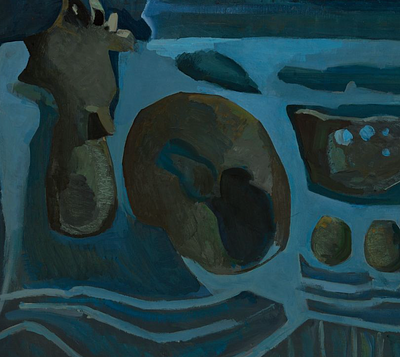EMILIO GRAU SALA (Barcelona, 1911 - 1977). "Figures in the garden", 1943. Oil on canvas.
Lot 87
About Seller
Setdart Auction House
Carrer Aragó 346
Barcelona
Spain
Setdart Subastas was born in 2004 and is currently the first online art auction in Spain with solidity, prestige and reliability guaranteed by our more than 60,000 users. Setdart has a young, dynamic and enterprising team ready to successfully manage the purchase and sale of art works through custom...Read more
Estimate:
EUR€5,000 - EUR€7,000
$5,154.64 - $7,216.49
Absentee vs Live bid
Two ways to bid:
- Leave a max absentee bid and the platform will bid on your behalf up to your maximum bid during the live auction.
- Bid live during the auction and your bids will be submitted real-time to the auctioneer.
Bid Increments
| Price | Bid Increment |
|---|---|
| EUR€0 | EUR€10 |
| EUR€200 | EUR€25 |
| EUR€500 | EUR€50 |
| EUR€1,000 | EUR€100 |
| EUR€3,000 | EUR€200 |
| EUR€5,000 | EUR€500 |
| EUR€10,000 | EUR€1,000 |
| EUR€20,000 | EUR€2,000 |
| EUR€50,000 | EUR€5,000 |
About Auction
By Setdart Auction House
Jul 27, 2021
Set Reminder
2021-07-27 08:00:00
2021-07-27 08:00:00
America/New_York
Bidsquare
Bidsquare : CONTEMPORARY AND ACTUAL ART
https://www.bidsquare.com/auctions/setdart-auction-house/contemporary-and-actual-art-7261
Setdart Auction House sofia@setdart.com
Setdart Auction House sofia@setdart.com
- Lot Description
EMILIO GRAU SALA (Barcelona, 1911 - 1977). "Figures in the garden", 1943. Oil on canvas. Signed and dated in the lower right corner. Attached certificate issued by Julian Grau Santos. Measures: 28 x 35,5 cm; 48 x 68,5 cm (frame). Son of the draftsman Juan Grau Miró, Grau Sala combined his attendance to the School of Fine Arts of Barcelona with an essentially self-taught formation. In 1930 he held his first exhibition at the Badriñas gallery in Barcelona. At the beginning of the Civil War, in 1936, he moved to Paris, where he settled in the Spanish artists' colony of Montparnasse. That same year he was awarded the first Carnegie Prize. In the twenty-five years that he remained there, he was closely acquainted with the avant-garde, although he always opted for a colorist figuration, derived from impressionism and fauvism. It was a path already taken by the commercial circuit, surpassed in terms of novelty by cubism and surrealism, but which was kept alive at a high level thanks to masters such as Bonnard, Chagall and Dufy. In fact, he soon became known in Paris as the successor of the Impressionist spirit and values, directly related to Bonnard and Vuillard. This stylistic choice of Grau Sala conditioned that of his wife, Ángeles Santos, who abandoned her singular surrealism for a more conventional landscape, a decision that critics did not hesitate to regret. The success of his style led Grau Sala to dedicate himself also to graphic work, an example of which are his engravings, lithographs, illustrations for novels, and posters, as well as theatrical sets. The grace and delicacy of his characters, the vividness of the colors and the elegant atmosphere of the environments that he captured made him reap great success and recognition around the world. He held several solo exhibitions, mainly in Barcelona and Paris, but also in cities such as New York, Toulouse, London and Los Angeles. In 1963 he returned to Barcelona, when the stagnant figuration of Franco's Spain began to be challenged by Oteiza, Chillida, Tàpies and the collective "El Paso". However, he remained faithful to his style, and until his death in 1975 he worked within his own personal line, focused on themes such as female figures, interiors and landscapes, in a vaguely classical, nostalgic time setting of the nineteenth century. After his death, and for more than a decade, Grau Sala was overshadowed by the multiple novelties that were emerging in democratic Spain, but from the 1990s onwards, the new boom in mid-level collecting relaunched Grau Sala, as he was understood as an interpreter of Impressionism in a Spanish key. Today, works by Emilio Grau Sala are kept in the National Museum of Art of Catalonia, the Esteban Vicente Museum of Contemporary Art and the Óscar Domínguez Institute of Contemporary Art and Culture.
- Shipping Info
-
In-house shipping available. Please inquire at admin@setdart.com.
-
- Buyer's Premium



 EUR
EUR CAD
CAD AUD
AUD GBP
GBP MXN
MXN HKD
HKD CNY
CNY MYR
MYR SEK
SEK SGD
SGD CHF
CHF THB
THB
















